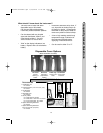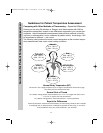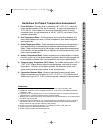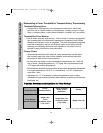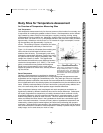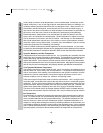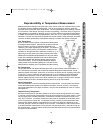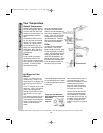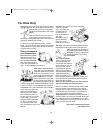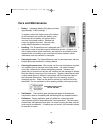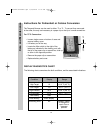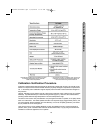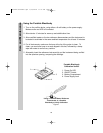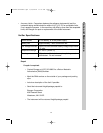
Forgotten Physiology
Perspiration
The TemporalScanner relies on the skin over the temporal artery to help provide an accu-
rate body temperature. In fact, it is measuring the inside by measuring the outside. Your
skin is a sensor, controlling body temperature in two ways: radiation and evaporation.
Since most of us don’t think about our skin as a sensor, this might be a good time to dis-
cuss a little physiology.
We live our entire lives with a body temperature that changes only a few degrees. This is
thanks to a very sophisticated climate control, of which the skin is a very important part.
Sweating, goose bumps, and heat loss from the skin all help maintain our normal tempera-
ture, keeping us comfortable.
When your internal temperature rises, your brain signals your blood to increase circulation
to the skin. In this way, the body’s internal heat is carried to the surface by the blood,
where it is lost by radiation.
If this is not sufficient, your sweat glands sprint into action, and perspiration is released
through the pores. This liquid evaporates on your skin and you cool right down. When
your temperature drops, your brain signals that heat must now be saved. Less blood circu-
lates to the skin, and sweating stops.
Since there is a lot of cooling going on when you are sweating, both inside and out, it is a
good idea to wait till your forehead is dry before taking your temperature with the
TemporalScanner. If your forehead is sweaty, the reading would be low. Drying your fore-
head could help shorten the wait, but there is another place to measure an accurate tem-
perature when perspiring. It is still on the head, but in the little soft depression just behind
the ear lobe, the place where young ladies are usually taught to apply perfume.
During perspiration, taking a temperature with the TemporalScanner in the area behind the
ear lobe has been proven to be as accurate as a temperature taken at the temporal artery
area, were it not wet. Since we sweat first on the forehead, then on the hands and feet,
the chances of the area behind the ear lobe remaining dry for the measurement are excel-
lent. And since we already have increased circulation to the skin during perspiration, this
area will have the high blood flow necessary for the measurement.
Another instance when a high rate of blood flow on the neck can be assured is following
head trauma, either surgical and accidental. At such times the neck area behind the ear
lobe can be used as a primary site if the forehead is not available.
If perspiration or head trauma is not present, the area on the neck behind the ear lobe may
not have sufficient blood flow to be reliable, and should not be used as the primary meas-
urement site.
If there is heavy perspiration, including moisture behind the ears, wait until area is dry.
For use on exercising athletes or other non-clinical subjects, contact Exergen.
21
818528r5:818528r5.qxd 4/24/2008 11:05 AM Page 23



